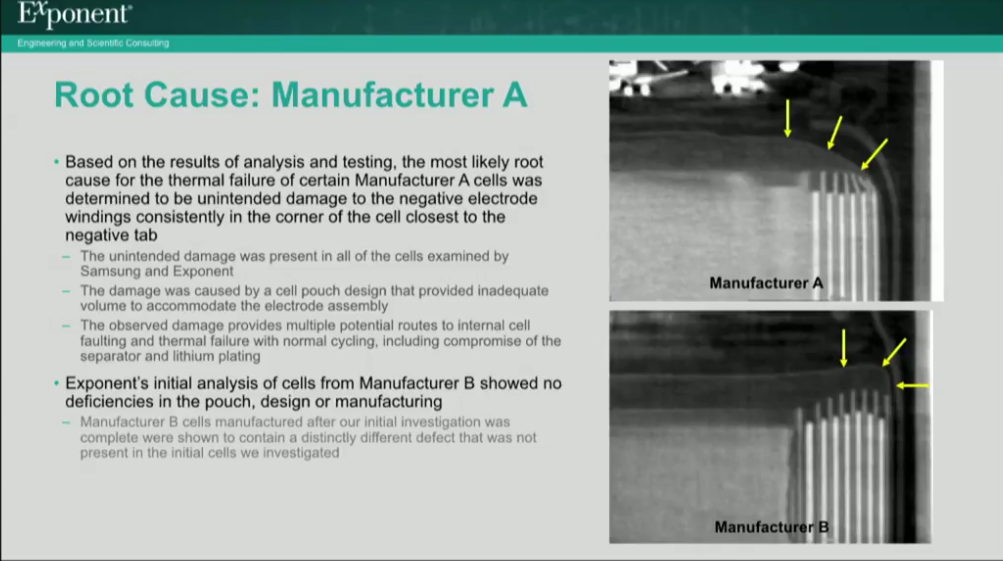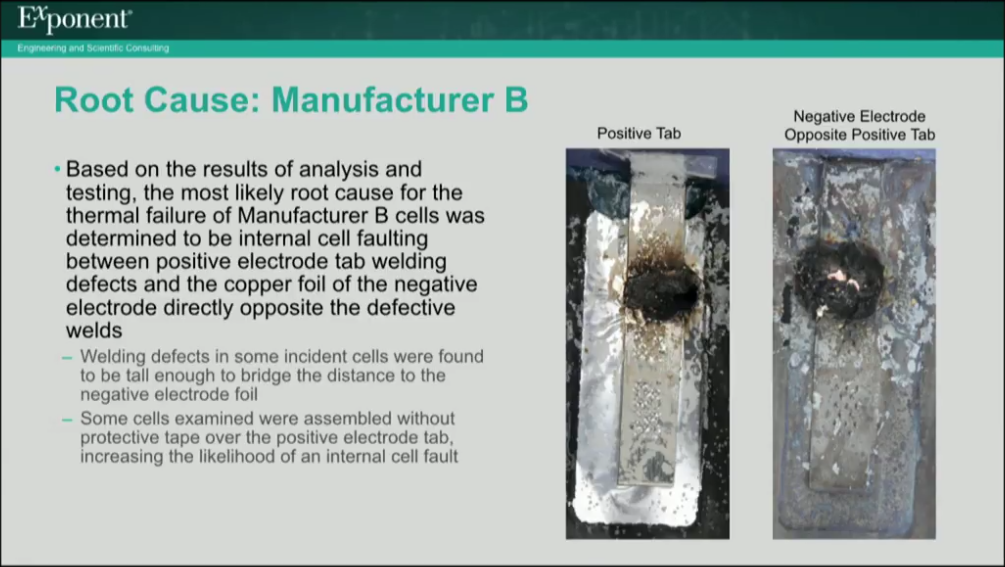aNewDomain — He’s sorry. Really.
And by the way, Samsung Electronics isn’t to blame for its Galaxy Note 7 exploding and overheating battery disaster.
That was the gist of Samsung Mobile president D.J. Koh’s remarks at a sober press conference Sunday. The beleaguered Korean giant has concluded a massive, three-month-long investigation into what caused its flagship Samsung Note 7 to overheat and even spontaneously catch fire, a glitch that led airlines the world over to ban the device by name in embarrassing airport loudspeaker messages.
The glitch, he said, boils down to five design and manufacturing flaws discovered in two battery models from two its OEM suppliers, he said. I’ll explain who, what, why and how it happened, in technical detail, too. But first, let’s backtrack to August 2016, back when the future looked rosy for the new flagship Note 7.
Solving a mystery
For consumers and industry observers who’d expected so much from the Note 7 last summer, it was like watching a car wreck. First, it’s out with great fanfare. But within days, reports and rumors around system failures and glitches began to trickle in to the tech trade press. Within a month, Samsung had announced the first of two devastating product recalls.
Then came the explosions, which at first seemed like the kind of rumor that only a competitor could dream up. It seemed hard to believe, though. It wasn’t until the airlines began treating the device as a device as anathema to flying as guns, weapons and Dasani bottles that the nightmare truly began.
Was it the worst PR disaster a tech company had ever known. Well, no. US vs Microsoft, in 1996, was worse. So was Apple back in 1996, when it grew dangerously close to becoming a penny close and had to beg its rival Microsoft for the dough it needed to save it.
But this was bad.
In the fall, Samsung did the only thing it could do — try to figure out what the problem was. It knew it was the battery, but what about the battery? And which battery? And where was the flaw actually happening and in what phase of the product cycle? There were a billion theories, jokes even, but no one knew.
The investigation that concluded yesterday was a massive response on Samsung’s part. It comprised more than 700 engineers, 200,000 battery-powered Note 7 devices, 30,000 standalone batteries. It also included three outside testing firms and four Asian testing facilities, which it built just for this purpose. And the costs? We’ll find out in quarterly year-end reports, maybe. It was painful, but it was a good and noble way to stop the bleeding.
At first, though, it looked like a fruitless waste of time. Investigators were at a loss. After testing everything they could think of that touched the batteries and phone, from software to hardware to firmware, from manufacturing to supply chain to QA control folk to assembly to shipping, they were at a loss.
At the conference today, testers said they examined every permutation of those combinations against various manufacturing processes and lines to no avail.
But late last fall, the break came. It was a lucky combination that revealed the culprits: Two battery makes and models from two different battery suppliers. It was the jackpot miracle hey needed.
So who were the culprits, who were the suppliers with the blood of melted Note 7s on their hands?
Samsung won’t say, except to say one is based in Vietnam and the other in China. (Some reports claim to have sources that pin the blame on Samsung Electronics’ many sister companies and a Chinese battery maker That’s unclear, though. For more on that, scroll below the fold)
For what it’s worth, Samsung has offered no comment on such theories, and neither has either of the named OEMs.
For its part, Samsung Electronics did repeatedly emphasize that its company had nothing to do with the design and manufacturing flaws in those batteries.
After making that comment, Samsung execs took a hard right and offered unusually detailed and deep tech explainers for exactly what happened. Here’s what the investigation revealed …
How to make an exploding phone
In the tech explainers that follow, we will use the same terms Samsung used to describe the two makers and two batteries at the heart of the mystery: Battery A from Manufacturer A supplied the battery that led to the September Note 7 recall.
The one responsible for the second recall, which involved the combusting Note 7s, was Manufacturer B’s Battery B.
Let’s take them one at a time.
Battery A, which led to the first, non-exploding Note 7 recall, overheated, execs said, because of a manufacturing fault in the battery’s upper right corner. Kevin White, a principal scientist at Exponent, one of the three companies Samsung tapped to run the investigation, went into deep detail what and how that happened. The upshot was, such anomalies and deformations, particularly near the curved corners, bent and deformed the negative electrodes into each other, a simple problem which made them short circuit. Easy.
The explanation for what would make a Note 7 explode, though, was well worth waiting for. CONTINUED BELOW

Battery B had”burrs,” the test exec said curtly. Chafing and roughness on the positive electrode surface caused tiny pieces to stand up and actually drive right through the insulation tape, breaking its seal, and even the separator that protects it.
This caused a direct connection with the negative electrode which, like it did in Battery A, led to battery short circuiting and failure.
And the explosion? What? How?
Some of the Battery B battery samples were missing the insulation tape altogether.
That’s all it takes to build a smartphone or tablet bomb, it turned out. Forget the tape. Add power. Boom. Check out the graphic below.

Is that all there is to a combustible Note 7?
So was that it? Samsung testers still weren’t certain. So they kept testing, adding protocols that went far beyond just testing batteries, the testing company reps said.
Testers scrutinized various kinds of charging scenarios on a variety of hardware, software and firmware combinations, and ran them through different manufacturing, Q and A and logistics possibilities, too.
In the end, the testers concluded there were no additional issues for the Note 7 battery overheating and fire issues beyond the two battery models.
All three independent testing companies presented results that confirmed those results, as did Samsung.
And about the identity of those battery makers …
Though Samsung refused to name the two suppliers it says were the source of the defective batteries, reports have been surfacing all day in the trade press, so far all seem to be pretty thinly sources.
A CNET report late Sunday night, for instance, quoted an unnamed rep from the US Consumer Product Safety Commission as pinning the Battery A crime on Samsung Electronic’s sister company, Samsung SDI (a sister company of Samsung Electronics). So far reps from that company have refused comment.
As for the maker of the exploding battery, the same unnamed source pointed CNET to a statement, in Chinese, on Hong Kong’s Amperex Technology site. He said the company had taken responsibility for it.
CNET didn’t offer a translation. Fortunately, one of our Chinese American staffers, not a native speaker but fluent, took a shot at it. Read it below. If it’s accurate, well, it is hardly a confession. Here it is:
“On Sept 18, 2016, the Chinese media reported about the Galaxy Note7 battery overheating problem. Our company, in conjunction with our honored customer Samsung Electronics, cooperated on a preliminary study to determine whether sample of our production batteries and the combustion (issues) had a direct relationship. According to burn traces (marks) we studied that were left on the sample (after an incident), we presume the heat source comes from outside, not inside, of the battery body — and that there is a great possibility that other external factors caused the overheating issue. We will continue to pay close attention to the use of the company’s products in the market.”
That message was signed, though, not by Amperex but by the New Energy Technology Co. When asked to comment, execs at both company divisions refused comment.
Maybe we missed something though. Here is the original Chinese statement CNET’s one anonymous source gave as evidence:

And that, it seems, is the end of the mystery of the exploding phone mystery. If you want more tech details, email me or leave a comment below and i’ll add them to the bottom of this story.
For aNewDomain, I’m Mike Olsen.
All screenshots: Mike Olsen.
Here’s an infographic that Samsung provided that digs in further.













